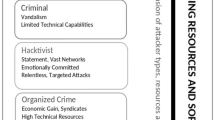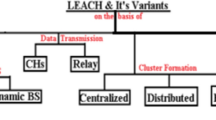Abstract
Node capture attacks compromise the integrity and confidentiality of networks by capturing nodes within them and obtaining cryptographic keys through wireless sensor network links. Adversarial modelling research is being conducted in order to develop efficient solutions for WSN security. Based on random key distribution scheme, an optimal graph-based technique is used to imitate node capture attack. The approach to estimating destructiveness is referred after evaluation of the relationships between keys to paths and nodes that uses graph-based modelling. The most destructiveness among all captured nodes is then secured through an optimal dominant graph (ODG), that simultaneously enhances attacking efficiency and speeds up execution. To examine the functionality of ODG with regard to the effectiveness within network, we created optimal attacking graphs, especially the optimal key graph (OKG) and optimal crossover graph (OCG). Proposed model multi objective optimization dominating algorithm (MOODA) in order to produce a path vulnerability matrix with the best possible accuracy using different objective functions that consist of multiple objectives, including dominating set of nodes, node contribution, key contribution, cost and crossover edges, to determine optimal node. The proposed matrix-based attack model by taking advantage of multiple vulnerabilities in the networks. We control a variety of processes to monitor system performance. Results show that MOODA obtain better result in increases attacking performance, decreases the total rounds, reduces accessing time, and saves cost of energy than other state of the art methods.




















Similar content being viewed by others
References
Abualigah L, Diabat A, Elaziz MA (2021) Improved slime mould algorithm by opposition-based learning and Levy flight distribution for global optimization and advances in real-world engineering problems. J Ambient Int Hum Comput 14:1–40
Ahlawat P, Dave M (2017) A hybrid approach for path vulnerability matrix on random key predistribution for wireless sensor networks. Wirel Pers Commun 94(4):3327–3353
Ahlawat P, Dave M (2018) A cost-effective attack matrix based key management scheme with dominance key set for wireless sensor network security. Int J Commun Syst 31(12):e3713
Ahutu OR, El-Ocla H (2020) centralized routing protocol for detecting wormhole attacks in wireless sensor networks. IEEE Access 8:63270–63282
Alemayehu TS, Kim JH, Cho WD (2021) Optimal replacement model for the physical component of safety critical smart-world CPSs. J Ambient Int Hum Comput 13:4579–4590
Balaji S, Sasilatha T (2019) Detection of denial of service attacks by domination graph application in wireless sensor networks. Clust Comput 22(6):15121–15126
Bhatt R, Maheshwary P, Shukla P, Shukla P, Shrivastava M, Changlani S (2020) Implementation of fruit fly optimization algorithm (FFOA) to escalate the attacking efficiency of node capture attack in wireless sensor networks (WSN). Comput Commun 149:134–145
Bonaci T, Bushnell L, Poovendran R (2010a) Probabilistic analysis of covering and compromise in a node capture attack. Network Security Lab (NSL), Seattle, WA, Techical Report, 1.
Bonaci T, Bushnell L, Poovendran R (2010b) Node capture attacks in wireless sensor networks: a system theoretic approach. In: Proceeding IEEE 49th international conference on decision and control, pp 6765– 6772
Chan K, Fekri F (2011) Node compromise attacks and network connectivity. Defense transformation and net-centric systems. http://trove.nla.gov.au/work/34974076?citationFormat=BibTeX&selected version=NBD42326214
Chan H, Perrig A, Song D (2003a) Random key predistribution schemes for sensor networks. In: Proceeding 2003a symposium on security and privacy, pp 197–213
Chan H, Perrig A, Song D (2003b) Random key predistribution schemes for sensor networks. In: Proceeding IEEE 24th international conference on security and privacy, pp 197–213
Chan K, Fekri F (2007) Node compromise attacks and network connectivity. Proc SPIE 6578:1–12
Chen X, Makki K, Yen K, Pissinou N (2007) Node compromise modeling and its applications in sensor networks. In: 12th IEEE symposium on computers and communications, pp 575–582
De P, Liu Y, Das S (2009) Deployment-aware modeling of node compromise spread in wireless sensor networks using epidemic theory. ACM Trans Sens Netw 5(3):1–33
De P, Liu Y, Das S (2006) Modeling node compromise spread in wireless sensor networks using epidemic theory. In: Proceeding IEEE 7th international symposium on world of wireless, mobile and multimedia networks, pp 237–243
Deng YJ, Li YQ, Qin YH, Dong MR, Liu B (2020) Optimal defense resource allocation for attacks in wireless sensor networks based on risk assessment model. Chaos Solitons Fractals 137:109780
Dhavakumar P, Gopalan NP (2021) An efficient parameter optimization of software reliability growth model by using chaotic grey wolf optimization algorithm. J Ambient Intell Humaniz Comput 12:3177–3188
Di Fazio AR, Erseghe T, Ghiani E, Murroni M, Siano P, Silvestro F (2013) Integration of renewable energy sources, energy storage systems, and electrical vehicles with smart power distribution networks. J Ambient Intell Humaniz Comput 4:663–671
Ehdaie M, Alexiou N, Ahmadian M, Aref MR, Papadimitratos P (2017) Mitigating node capture attack in random key distribution schemes through key deletion. J Commun Eng 6(2):99–109
Elavarasan D, Vincent PDR (2021) A reinforced random forest model for enhanced crop yield prediction by integrating agrarian parameters. J Ambient Int Hum Comput 12:10009–10022
Ergun M, Levi A, Savas E (2011) Increasing resiliency in multiphase wireless sensor networks: generation wise key predistribution approach. Comput J 54(4):602–616
Eschenauer L, Gligor VD (2002) A key-management scheme for distributed sensor networks. In: Proceeding 9th ACM conference on computer and communications security, pp 41–47
Grewal NS, Rattan M, Patterh MS (2017) A non-uniform circular antenna array failure correction using firefly algorithm. Wirel Personal Commun 97:845–858
Hong S, Lim S, Song J (2011) Unified modeling language based analysis of security attacks in wireless sensor networks: a survey. KSII Trans Internet Inf Syst 5(5):805–821
Hong S, Lim S (2010) Analysis and attack models via unified modeling language in wireless sensor networks: a survey study. In: Proceeding 2010 IEEE international conference on wireless communications, networking and information security (WCNIS), pp 692–696
Jayavadivel R, Prabaharan P (2021) Investigation on automated surveillance monitoring for human identification and recognition using face and iris biometric. J Ambient Intell Humaniz Comput 12:10197–10208
Jazayeri F, Shahidinejad A, Ghobaei-Arani M (2021) Autonomous computation offloading and auto-scaling the in the mobile fog computing: a deep reinforcement learning-based approach. J Ambient Intell Humaniz Comput 12:8265–8284
Karlof C, Wagner D (2003) Secure routing in wireless sensor networks: attacks and countermeasures. Ad Hoc Netw 1(2):293–315
Khare, A., Gupta, R., Shukla, P. K., Chowdhury, R., & Datta, P. K. (2021). A black widow optimization algorithm (BWOA) for node capture attack to enhance the wireless sensor network protection. In: Proceedings of International conference on computational intelligence, data science and cloud computing (pp. 603–617). Springer, Singapore
Kim D, Suh Y, Park J (2007) Toward assessing vulnerability and risk of sensor networks under node compromise. In: Proceeding IEEE 4th international conference on computational intelligence and security,pp 740–744
Li J, Wang D, Wang Y (2018) Security DV-hop localisation algorithm against wormhole attack in wireless sensor network. IET Wirel Sens Syst 8(2):68–75
Lin C, Wu G (2013) Enhancing the attacking efficiency of the node capture attack in wsn: a matrix approach. J Supercomput 66(2):989–1007
Lin C, Wu G, Xia F, Yao L (2013) Enhancing efficiency of node compromise attacks in vehicular ad-hoc networks using connected dominating set. Mob Netw Appl 18(6):908–922
Lin C, Wu G, Yu CW, Yao L (2015a) Maximizing destructiveness of node capture attack in wireless sensor networks. J Supercomput 71(8):3181–3212
Lin C, Wu G, Yim K, Yao L, Hou G (2015b). Compromising ad-hoc networks by attacking weakly connected dominating set. In 2015b 9th International conference on innovative mobile and internet services in ubiquitous computing, IEEE, pp 213–220
López M, Peinado A, Ortiz A (2016). A SEIS model for propagation of random jamming attacks in wireless sensor networks. In: International joint conference SOCO’16-CISIS’16-ICEUTE’16. Springer, Cham, pp 668–677
Mishra A, Turuk A (2010) Adversary information gathering model for node capture attack in wireless sensor networks. In: Proceedings IEEE international conference in devices and communication, pp 1–5
Mochalov VA (2015) Synthesis of the wireless sensor network structure in the presence of physical attacks. In: Andreev S, Balandin S, Koucheryavy Y (eds) Internet of things, smart spaces, and next generation networks and systems. Springer, Cham, pp 11–22
Mou J (2013) Adaptive consensus of distributed varying scale wireless sensor networks under tolerable jamming attacks. Math Probl Eng. https://doi.org/10.1155/2013/931934
Perrig A, Stankovic J, Wagner D (2004) Security in wireless sensor networks. Commun ACM 47(6):53–57
Shaila K, Manjula SH, Thriveni J, Venugopal KR, Patnaik LM (2011) Resilience against node capture attack using asymmetric matrices in key predistribution scheme in wireless sensor networks. Int J Comput Sci Eng 3(10):3490
Shukla PK, Goyal S, Wadhvani R, Rizvi MA, Sharma P, Tantubay N (2015) Finding robust assailant using optimization functions (FiRAO-PG) in wireless sensor network. Math Probl Eng. https://doi.org/10.1155/2015/594345
Singh S, Saini HS (2020) PCTBC: power control tree-based cluster approach for Sybil attack in wireless sensor networks. J Circuits, Syst Comput 30:2150129
Srivastava AK, Kumar S, Zareapoor M (2018) Self-organized design of virtual reality simulator for identification and optimization of healthcare software components. J Ambient Int Hum Comput. https://doi.org/10.1007/s12652-018-1100-0
Tague P, Poovendran R (2007) Modeling adaptive node capture attacks in multi-hop wireless networks. Ad Hoc Netw 5(6):801–814
Tague P, Slater D, Rogers J, Poovendran R (2008) Evaluating the vulnerability of network traffic using joint security and routing analysis. IEEE Trans Dependable Secure Comput 6(2):111–123
Tague P, Poovendran R (2008) Modeling node capture attacks in wireless sensor networks. In: Proceeding 46th annual Allerton conference on communication, control, and computing, pp 1221–1224
Tague P, Slater D, Rogers J, Poovendran R (2009) Vulnerability of network traffic under node capture attacks using circuit theoretic analysis. In: Proc IEEE 28th international conference on computer communications, pp 161–165
Usharani R, Shanthini A (2021) Neuropathic complications: type II diabetes mellitus and other risky parameters using machine learning algorithms. J Ambient Int Hum Comput. https://doi.org/10.1007/s12652-021-02972-w
Wang YC (2018) Prediction of engine failure time using principal component analysis, categorical regression tree, and back propagation network. J Ambient Int Hum Comput. https://doi.org/10.1007/s12652-018-0997-7
Zhao J (2016) On resilience and connectivity of secure wireless sensor networks under node capture attacks. IEEE Trans Inf Forensics Secur 12(3):557–571
Funding
This research received no external funding.
Author information
Authors and Affiliations
Contributions
All authors listed have made a substantial, direct and intellectual contribution to the work, and approved it for publication.
Corresponding author
Ethics declarations
Conflict of interest
All Authors declare that they have no conflict of interest.
Ethical approval
This article does not contain any studies with human participants or animals performed by any of the authors.
Informed consent
Informed consent was obtained from all individual participants included in the study.
Additional information
Publisher's Note
Springer Nature remains neutral with regard to jurisdictional claims in published maps and institutional affiliations.
Rights and permissions
Springer Nature or its licensor (e.g. a society or other partner) holds exclusive rights to this article under a publishing agreement with the author(s) or other rightsholder(s); author self-archiving of the accepted manuscript version of this article is solely governed by the terms of such publishing agreement and applicable law.
About this article
Cite this article
Ahlawat, P., Bathla, R. A multi objective optimization modeling in WSN for enhancing the attacking efficiency of node capture attack. Int J Syst Assur Eng Manag 14, 2187–2207 (2023). https://doi.org/10.1007/s13198-023-02048-2
Received:
Revised:
Accepted:
Published:
Issue Date:
DOI: https://doi.org/10.1007/s13198-023-02048-2




